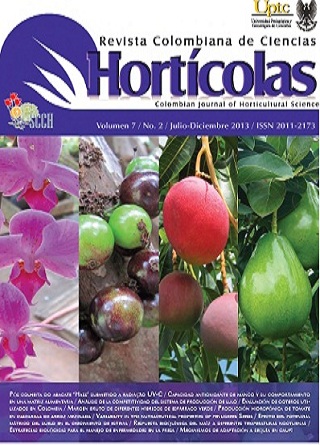Variability in the nutraceutical properties of fenugreek (Trigonella foenum-graecum L.) sedes

Resumen
Fenugreek (Trigonella foenum-graecum L.) leaves and seeds have been used extensively for medicinal purposes. Fenugreek seed is known to exhibit anti-diabetic properties and effects such as hypocholesterolaemic, anticancerous and thyroxine-induced hyperglycaemia. The result of the present experiment reveals considerable variability among fenugreek genotypes. They differ in morphology, growth habit, biomass and seed production capability. Chemical constituents of the seed, e.g. polyphenol, phytic acid, saponin, carbohydrate, protein and proximate analysis (moisture %, ash, fiber, Zn, Fe, Mn, and Mg) contents also differed markedly. This variability is most often overlooked or underestimated in clinical trials. Our research suggests that the genetic variability and the genotype by environmental interaction will play a significant role when the crop is used by the nutraceutical industry. Our research results indicate that the variability for important traits in fenugreek have a genetic base, making selection for improved levels of these traits possible. Fenugreek plays a major role to progress towards the exploitation of crop to overcome micronutrient deficiency in human beings. The associated issues to strengthen crop biofortification through fenugreek research and development have been dealt in this piece of research work.
Citas
- Abd El-Aal, M.H. and E.H. Rahma. 1986. Changes in gross chemical composition with emphasis on lipid and protein fractions during germination of fenugreek seeds. Food Techn. 9 (2), 53-59.
- Acharya, S., A. Srichamroen, S. Basu, B. Ooraikul, and T. Basu. 2006. Improvement in the nutraceutical properties of fenugreek (Trigonella foenum-graecum L.) Songklanakarin J. Sci. Technol. 28 (Suppl. 1), 1-9.
- AOAC 1995. Official methods of analysis. Association of Official Analytical Chemists, Washington D.C.
- Asada, K. K., Tanaka, and Z. Kasai. 1969. Formation of phytic acid in cereal grains. Ann. N.Y. Acad. Sci. 165, 801-814.
- Avtar, R., A.S., Rathi, D.S. Jatasra, and U.N. Joshi. 2003. Changes in phenolics and some oxidative enzymes in fenugreek leaves due to powdery mildew infection. Acta Phytopathologica et Entomologica Hungarica 38(3-4), 237-244.
- Budavari, S. 1996. The merck index: An encyclopedia of chemicals, drugs, and biological. 12th ed. N.J. Merk & Co, Inc., Whitehouse Station, NJ.
- Cerdon, C., A. Rahier, M. Taton, and Y. Sauvaire. 1995. Effects of tetcyclacis on growth and on sterol and sapogenin content in fenugreek. J. Plant Growth Regul. 14(1), 15-22.
- Cochran, G.W. and G.M. Cox 1950. Experimental designs. John Wiley and Sons, New York, NY.
- Fisher, R.A. and F. Yates 1963. Statistical tables for biological, agricultural and medical research. Oliver and Boyd, London.
- Gopalan, C., B.V. Rama Sastri, and S.C. Balasubramanian. 1992. Nutritive value of Indian Foods. NIN, ICMR, Hyderabad 19, 13-22.
- Gupta, K. and J. Singh. 2002. Anti-nutritional and flatulence factors at various stages of vegetative growth of fenugreek (Trigonella foenum graecum L.) leaves. J. Food Sci. Technol. 39(5), 525-527.
- Hedge, J.E. and B.T. Hofreiter. 1962. Methods of estimating starch and carbohydrates. Pp. 163-201. In: Whistler, R.L. and Be Miller, J.N. (eds.). Carbohydrate chemistry 17. Academic Press, New York, NY.
- Kochhar, A., M. Nagi, and R. Sachdeva. 2006. Proximate composition, available carbohydrates, dietary fibre and anti nutritional factors of selected traditional medicinal plants. J. Hum. Ecol. 19(3), 195-199.
- Lin, J.T. and D.J. Yang. 2008. Determination of steroidal saponins in different organs of yam (Dioscorea pseudojaponica Yamamoto). Food Chem. 1089, 1608-1674.
- Lowry, O.H., N.J. Rosebrough, A.L. Farr, and R.J. Randall. 1951. Protein measurement with Folin reagent. J. Biol. Chem. 193, 265-273.
- Malik, C.P. and M.B. Singh, M.B. 1980. Peroxidase. p. 286. In: Plant enzymology and histo enzymology. Kalyani Publisher, New Delhi, India.
- Max, B. 1992. This and that - the essential pharmacology of herbs and spices. Trends Pharmacol. Sci. 13, 15-20.
- Meenakshi, J.V., N.L. Johnson, V.M. Manyong, H. De-Groote, J. Javelosa, D.R. Yanggen, F. Naher, C. Gonzalez, J. García, and E. Meng. 2010. How costeffective is biofortificationin combating micronutrient malnutrition. An ex ante assessment. World Development 38(1), 64-75.
- Mehrafarin, A., A. Qaderi, S. Rezazadeh, H. Naghdibadi, G. Noormohammadi, and E. Zand. 2010. Bioengineering of important secondary metabolites and metabolic pathways in fenugreek (Trigonella foenum graecum L.). J. Medicinal Plants 9(35), 1-18.
- Nasroallah, M. and M. Kolsum. 2013. Physiological and pharmaceutical effects of fenugreek (Trigonella foenum-graecum L.) as a multipurpose and valuable medicinal plant. Global J. Medicinal Plant Res. 1(2), 199-206.
- Newall, C.A., L.A. Anderson, and J.D. Phillipson. 1996. Herbal medicines: A guide for healthcare professionals. The Pharmaceutical Press, London.
- Qaim, M. A., J. Stein, and J.V. Meenakshi. 2007. Economics of biofortification. Agric. Econ. 37, 119-133.
- Rao, D.S.S, and Y.G. Deosthale. 1981. Mineral composition of four Indian food legumes. J. Food Sci. 46, 1962-1963.
- Singh, P., U. Singh, M. Shukla, and R.L. Singh. 2010. Variation of some phytochemicals in methi and saunf plants at different stages of development. J. Herbal Medicine Toxicol. 4(2), 93-99.
- Siow Y.T., K.Y. Chi, T. Elad, P.G. Raymond, R.M. Welch, L. Xingen, and D.D. Miller. 2008. Iron bioavailability to piglets from red and white common beans (Phaseolus vulgaris). J. Agric. Food Chem., 56 (13), pp 5008-5014.
- Stein, A.J., J.V. Meenakshi, and M. Qaim. 2008. Potential impacts of iron biofortification in India. Social Sci. Medicine 66(8), 1797-1808.
- Stewart, W.M., D.W. Dibb, A.E. Johnston, and T.J. Smyth. 2005. The contribution of commercial fertilizer nutrients to food production. Agron. J. 97, 1-6.
- Sumayya, A.R., S. Sivagami, and A. Nabeelah. 2012. Screening and biochemical quantification of phytochemicals in fenugreek (Trigonella foenum-graecum). Res. J. Pharm. Biol. Chem. Sci. 3(1), 165-169.
- Welch, R.M. 2001. Micronutrients, agriculture and nutrition; linkages for improved health and well being. Science Publisher, Jodhpur, India. pp. 247- 289.
- Wheeler, E.L. and R.E. Ferrel. 1971. A method for phytic acid determination in wheat and wheat fractions. Cereal Chem. 48, 312-320.